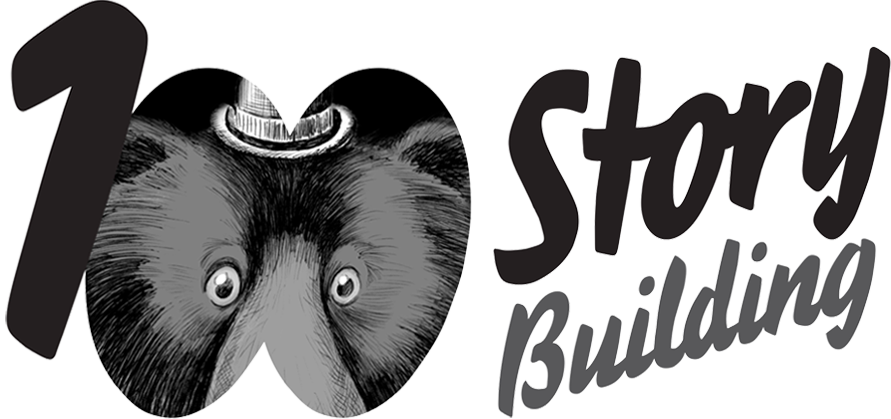Why go Perilous Questing?
Article by Simon Conlon
Program Manager Simon Conlon facilitates a workshop with teachers. Image by Brenna Ternus
‘A Perilous Quest’ into a 100 Story Building Workshop
One of our longest running workshop offerings is ‘A Perilous Quest’. All of the facilitators at 100 Story Building have delivered it, sometimes hundreds of times, to children, young people and adults alike. It is a 2 hour, jam-packed flurry of activities, ideas and drawings that starts from zero and doesn’t let up until we are almost at the final showdown with the evil villain. Whether it’s at our building in Footscray, classroom, or community space, everyone walks away with their own story bursting out in the form of a graphic novel.
If you were a fly on the wall in one of these workshops, you would see the usual ingredients of a story springing to life on each student’s page: a character appears from two animals being squished together, a villain appears not long after. Character motivations crystalise, albeit fairly nonsensical ones, that pull our hero out of their everyday life into the fray of an adventure. Brown-paper maps hold settings with obstacles that stop our hero in their path and a backpack full of everyday objects offer our authors options to generate wild and inventive solutions that overcome, as well as lead ever closer to our villain, the showdown and hopefully our hero’s prize. It sounds like a lot and it is, but all these components pop into the room without too much strain. Any blank pages spotted by our roaming facilitators usually need only a question or two to jumpstart the scribbling flow of having an idea and expressing it.
Now, if you were a fly on the wall that hung around for a while: maybe you ate some of the apple core that fell behind the bin and you got to see a few of these Perilous Quests, you might spot some patterns running in the workshop. You might see some of the intentional choices that have been made in the design and the delivery.
Combining ideas, like squishing together animals, allows for complexity. Familiar elements, broken apart, lead to original, never-before-seen ideas that have richness and are within reach for young participants. They can quickly answer what their Lion-Shark’s favourite food is, where they live, and what they dream of. Combining ideas moves us quickly past the early, blank page stages of ‘what could my idea be?’ and onto the easier question of ‘how do these things work together?’
Students enjoy participating in ‘A Perilous Quest’ workshop at 100 Story Building.
Idea generation activities are contained and manageable, but the results get purposefully stacked together, each making its own plot milestone with ease. Young authors answer the prompts and create before they know it - like vegetables hidden in the sauce, wild stories before they realise that they are story-making. They are given carefully shaped containers to fill with their ideas and the containers together create the scaffold for their ‘hero’s journey’.
The student’s experience of the workshop is one of being surrounded by an environment of creativity. At 100 Story Building, they see student work on the walls, in the books published in through our Early Harvest publishing program and in the other-worldly rooms that house them for a few hours. In their own classroom, facilitators ask for their help, and for their ideas to populate the activities that are being modelled in front of them. They see that there are no wrong answers, they also learn that there is no right answer. At least not a singular correct answer, but rather, many possibilities that all have just as much potential and value as each other.
They see other students putting up their hands, venturing an idea and it being folded into the facilitator’s story: affecting the journey, building out the world and spawning further ideas. Classmates decide on small details like the colour of a single insect-wing, or a more complex concept of an almost impossible-to-overcome obstacle. This all gets added into the melting-pot of a story.
In this rolling-boil of ideas, a student tests the boundaries of this ‘anything-goes’ playground. Hand goes up and they throw in a little hand-grenade of an offer, “A toilet!!”
“Sure, why not?” and suddenly our hero is setting out on their adventure to find the Golden Toilet of Truth. They get their laugh and are still part of the group seeing their ideas reflected back.
Teacher’s can see humour, silliness and nonsense being used as a tool. Lowering the ‘risk’ that can appear when creative work is the focus, when a correct answer might be elusive. They often see their quiet student in class isn’t being quiet at the moment. And the chatty one has written the most they have all year.
Whiteboard brainstorm for A Perilous Quest workshop.
I watch the facilitator navigating the uncertainty of this creative process. There is no pre-made example of what a good outcome looks like in this workshop, there is no well-trodden spiel about what the facilitator wants to put in their story; they are asking the students for the ideas, for their input on this example.
But the kids might say anything? How do you know that their ideas will make a good enough story?
The answer is always, because anything can be in a story, and a story can be about anything - you only have to trust that it will get there. Children and young people (and grown-ups) have a strong intuition for stories. We may not know how to sit down and make a whole one with ease, but we can see what the next small step could be and we can smell when it’s not quite right.
A bit like a fly.



